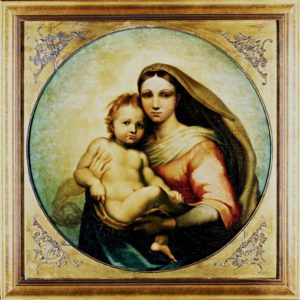Over a year ago, I wrote about artificial intelligence used in art authentication. This became a popular subject mainly because of an AI program’s use by researchers who concluded that the Rubens work Samson & Delilah at London’s National Gallery is most likely a copy or forgery. While many jumped the gun at the time, saying that AI and automation may replace living humans in art authentication, I was skeptical. AI is a tool and should be used as such, not as a whole-hog replacement for living scholars. And recently, AI has been in the news again thanks to British researchers and their use of facial recognition software in authenticating a possible Raphael.
Researchers from several British universities have concluded that a Madonna and Child painting known as the De Brécy Tondo is likely the work of the Italian Renaissance master Raphael Sanzio. Using facial recognition analysis, researchers compared the De Brécy Tondo with a similar Madonna and Child work by Raphael known as the Sistine Madonna, owned by the Gemäldegalerie Alte Meister in Dresden. Such facial recognition software found the two Madonnas’ faces were 97% similar. For years, many experts believed the De Brécy Tondo was a nineteenth-century copy of the Sistine Madonna. However, new research shows otherwise. Chemical tests run on the pigments in 2004 showed that the creator applied Renaissance-era materials and techniques in its creation. Furthermore, researchers traced the provenance back through the Wynne-Eyton family to a seventeenth-century ancestor Sir Richard Wynn, who served as treasurer and receiver-general to Queen Henrietta Maria of England. The fact that the queen’s monogram is stamped on the back of the canvas makes it likely that the queen gifted the painting to Wynn. The family kept it until its 1981 sale to the British art collector George Lester Winward.
Shortly before his death, Winward founded the De Brécy Trust to preserve his art collection and make the works available to researchers for future study. While the De Brécy Trust agrees with some experts’ positive attribution of the Tondo as a Raphael, they are definitely a minority. There has been consistent opposition to a positive Raphael attribution for decades. Before his 2020 death, the German art historian Jürg Meyer zur Capellen, one of the world’s foremost experts on Raphael, offered several rebuttals that still apply even without the new data from facial recognition analysis. Meyer zur Capellen noted that the tondo is on canvas. While Raphael did create some paintings on canvas, including the Sistine Madonna, all of Raphael’s paintings on canvas had one thing in common. Whether it’s the Sistine Madonna, the Portrait of Baldassare Castiglione, or La Velata, the paint is not applied so thickly as to cover the canvas’s woven texture. Meanwhile, in the De Brécy Tondo, the texture of the canvas is completely covered up with a layer of priming paint. Meyer zur Capellen also points out that the shading on the figures has an odd green quality, almost like oxidized copper. This stands in stark contrast with the warmth of the colors seen in the Sistine Madonna.
It’s also important to point out that the researchers who have provided this new data using facial recognition software are not art historians or experts in art curation or preservation. Dr. Christopher Brooke from the University of Nottingham is an expert in digital image analysis. His partner, Dr. Hassan Ugail, is a professor of visual computing at the University of Bradford. So, while I applaud their enthusiasm and interest in the arts, artificial intelligence alone, wielded by experts outside the field, won’t be making any earth-shattering discoveries anytime soon. Even if the faces of the two Madonnas were a complete match, it doesn’t mean that the same person created the two. In the words of art historian Fabrizio Federici, “a copy tries to look like the original, otherwise it would not be a copy.”

